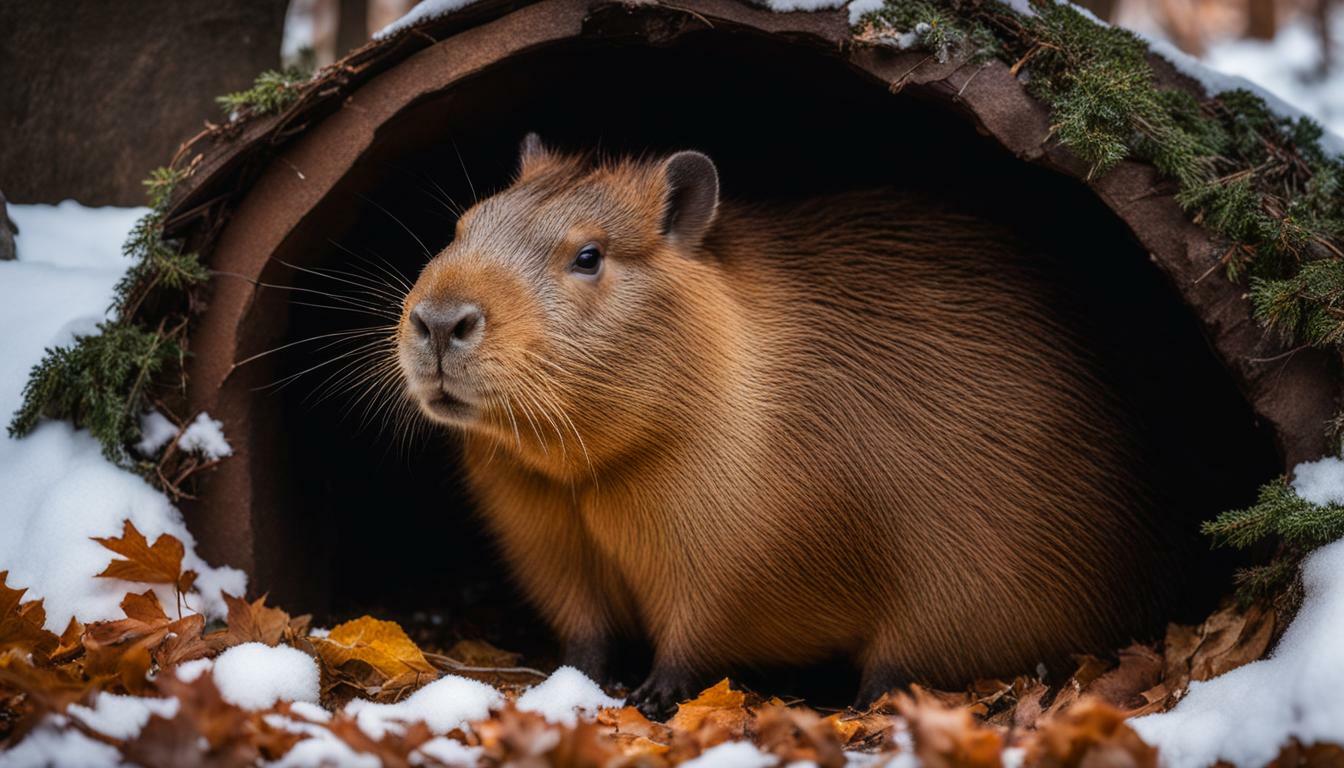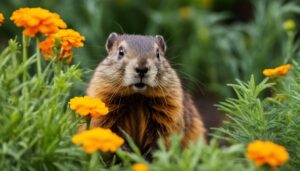Capybaras are fascinating creatures, but do they hibernate during the winter? Many people wonder about the sleeping patterns and behaviors of these large rodents when the colder months arrive. In this article, we will explore whether capybaras hibernate, how they adapt to the winter season, and what measures can be taken to ensure their well-being in colder climates.
Key Takeaways:
- Capybaras do not hibernate but remain active during the winter months.
- They seek shelter in burrows or under vegetation to escape extreme cold and wind.
- Capybaras have physical adaptations to survive in cold weather, such as thick fur and the ability to store fat for energy.
- Providing warm and dry shelter, ample food and water, and opportunities for exercise are crucial for capybaras in colder climates.
- Maintaining a comfortable environment with suitable temperature and humidity levels is essential for the well-being of capybaras in winter.
Capybara Winter Behavior
During the winter months, capybaras exhibit unique behaviors to survive the cold weather. Despite the freezing temperatures, capybaras are quite active and enjoy spending time outdoors. They do not hibernate like some other animals; instead, they seek shelter in burrows or under vegetation to escape extreme cold and wind.
Capybaras are well adapted to the cold months of winter. They have a thick fur coat that keeps them warm and insulated. Their strong front teeth and claws enable them to dig burrows, which provide them with a safe and cozy place to rest. Additionally, capybaras have the ability to store fat in their tails, allowing them to have extra energy reserves during periods of food scarcity.
Another fascinating winter behavior of capybaras is their ability to seek shelter from predators. They are alert and cautious, always on the lookout for potential threats. They often form groups or stay close to water sources to increase their safety. These adaptations help capybaras survive the challenges of the winter season.
When keeping capybaras as pets in colder climates, it is important to provide them with a suitable environment. This includes warm and dry shelter, plenty of food and water, and opportunities for exercise. Ensuring a comfortable temperature and humidity level is also crucial for their well-being. By providing these essentials, you can help your pet capybara thrive during the winter months.
Table 1: Capybara Winter Adaptations
| Adaptation | Description |
|---|---|
| Thick Fur Coat | Insulates capybaras and keeps them warm in cold temperatures. |
| Strong Front Teeth and Claws | Enables capybaras to dig burrows for shelter from extreme cold. |
| Tail Fat Storage | Allows capybaras to store extra energy reserves during food scarcity. |
| Group Living | Capybaras stay close to water sources and form groups for increased safety. |
By understanding capybara winter habits and providing appropriate care, you can ensure the well-being and happiness of these fascinating creatures during the colder months.
Capybara Winter Survival Adaptations
Capybaras have evolved remarkable adaptations that help them withstand the challenges of cold weather. These adaptations enable them to thrive during the winter months when temperatures drop and food becomes scarce.
One of the most noticeable adaptations of capybaras is their thick fur. This dense coat serves as insulation, keeping them warm even in freezing temperatures. The fur traps a layer of air close to the skin, providing an extra barrier against the cold. Additionally, capybaras have the ability to fluff up their fur, creating more insulation and better heat retention.
Another adaptation that aids capybaras in winter survival is their strong front teeth and claws. These teeth are constantly growing, allowing capybaras to effectively break down tough vegetation, their primary food source during winter. The claws, on the other hand, are instrumental in digging burrows, which capybaras use as shelter from the cold and harsh weather conditions.
Capybaras also possess a unique ability to store fat in their tails. This fat serves as an energy reserve during times when food is scarce. By storing fat in their tails, capybaras can stay energized and maintain their body temperature even when they have limited access to food sources. Additionally, capybaras are adept at seeking shelter from predators during winter, further increasing their chances of survival.
| Winter Adaptations of Capybaras |
|---|
| Thick fur for insulation |
| Strong front teeth and claws for food and burrow excavation |
| Ability to store fat in the tail for extra energy |
| Capability to seek shelter from predators |
These remarkable adaptations allow capybaras to not only survive but also thrive in cold weather conditions. Whether in the wild or as pets in colder climates, capybaras can endure the challenges of winter with their physiological and behavioral adaptations. However, for capybaras kept as pets, it is important to provide them with additional care to ensure their well-being during the winter season.
Capybara Burrows and Shelter
Capybaras seek shelter in burrows during harsh winter conditions as part of their hibernation behavior. These large rodents create burrows by digging into the ground using their strong front teeth and claws, providing a safe and warm space to protect themselves from the extreme cold and wind. Burrows typically have multiple entrances and interconnected chambers, allowing capybaras to move around and find comfort.
Inside the burrows, capybaras create cozy bedding areas using leaves, grass, and other natural materials. These bedding areas provide additional warmth and insulation against the cold. Capybaras also utilize dense vegetation, such as thick bushes or dense trees, to shield themselves from harsh weather conditions.
While capybaras do seek shelter in burrows and under vegetation, they are not true hibernators. Unlike animals that undergo a prolonged period of inactivity, capybaras remain relatively active during the winter months. They still venture out regularly in search of food and water, although their activity levels may decrease compared to other seasons.
It is important to note that capybaras are capable of burrowing underwater as well, using their ability to hold their breath for an extended period. This allows them to escape predators and find shelter in aquatic environments if necessary.
| Hibernation Behavior |
|---|
| Capybaras seek shelter in burrows during winter |
| They create cozy bedding areas using natural materials |
| They utilize dense vegetation for additional protection |
| Capybaras remain relatively active during winter |
| They can burrow underwater to escape predators |
Capybara Winter Activity Levels
Despite the colder temperatures, capybaras remain active during winter and display unique behavioral patterns. These fascinating creatures are well-adapted to thrive in wintry conditions while still engaging in their daily activities. Although they seek shelter to escape extreme cold and wind, capybaras do not hibernate like some other animals. Instead, they continue their routine of foraging for food and socializing with their group.
During winter, capybaras may decrease their overall activity levels compared to other seasons, but they still venture out regularly. They are often seen exploring their surroundings or taking refreshing dips in the water, even when it’s icy. Capybaras have a dense layer of fur that helps insulate them from the cold, enabling them to withstand freezing temperatures. Their activity levels may vary depending on the availability of food and water sources in their habitat.
In addition to their winter activities, capybaras also engage in unique behaviors to stay warm and conserve energy. They often gather in groups, known as herds, to huddle together for warmth. By doing so, they can collectively share body heat, providing each individual with additional insulation against the chill. These communal gatherings not only help them stay warm but also foster social bonds within the group.
| Common Capybara Winter Activities: |
|---|
| Foraging for food |
| Socializing with other capybaras |
| Exploring their surroundings |
| Taking dips in water bodies |
| Gathering in herds for warmth |
Despite the challenges posed by winter, capybaras exhibit remarkable resilience and adaptability. Their ability to remain active and find ways to stay warm is a testament to their survival instincts and the unique characteristics that make them such fascinating creatures.
Capybara Winter Diet
Capybaras adjust their diet during winter months to accommodate for limited food sources. In colder climates, vegetation becomes scarce, and the capybaras’ primary food source, such as grasses and aquatic plants, may be less abundant. To ensure their survival, capybaras supplement their diet with other available food sources.
During the winter, capybaras rely heavily on woody vegetation, such as bark, twigs, and branches, which provide essential nutrients and fiber. They also consume a variety of fruits, vegetables, and even crops, if available. Their ability to adapt their diet is crucial to sustain themselves during the winter months when their usual food sources are scarce.
In addition to their adjusted diet, capybaras also have a unique digestive system that allows them to efficiently process plant matter. Their large cecum, a part of the digestive tract, aids in the breakdown of fibrous material and allows them to extract more nutrients from the food they consume.
| Winter Diet: | Food Sources: |
|---|---|
| Woody vegetation | Bark, twigs, branches |
| Fruits and vegetables | Variety of available options |
| Other | Crops, if accessible |
In summary, capybaras adjust their diet during the winter months to cope with the scarcity of their usual food sources. They consume woody vegetation, fruits, vegetables, and even crops if available. Their unique digestive system allows them to efficiently process plant matter and extract the necessary nutrients for their survival. By adapting their diet, capybaras can thrive even in colder climates with limited food resources.
Capybaras as Pets in Winter
If you have a pet capybara and live in a colder climate, it’s essential to take specific precautions during winter. While capybaras are adapted to survive the cold months, providing them with the right care and environment is crucial for their well-being and winter survival. By following a few guidelines, you can ensure that your capybara remains healthy and comfortable throughout the winter season.
Providing Warm and Dry Shelter
During winter, capybaras need a warm and dry shelter to protect them from the harsh elements. Ideally, the shelter should be well-insulated and free from drafts. You can create a cozy space for your capybara by adding extra bedding, such as hay or straw, which will help to retain warmth. Additionally, consider using heat lamps or heating pads to provide extra warmth, especially during extremely cold periods.
Plenty of Food and Water
Capybaras require a substantial amount of food and water, especially during winter when their natural food sources may be limited. Ensure that your pet has access to fresh, clean water at all times. Additionally, provide a diet rich in fibrous vegetation, such as grasses and hays, to meet their nutritional needs. Consult with a veterinarian to determine the appropriate diet and feeding schedule for your capybara during winter.
Opportunities for Exercise and Comfort
Despite the colder temperatures, capybaras still need opportunities for exercise and mental stimulation. Create an enclosed outdoor area where your capybara can safely roam and explore. Additionally, provide a soft and comfortable resting area where they can relax and retreat to when they need to warm up. Remember to monitor their activity levels to prevent overexertion and ensure they have adequate rest.
| Precautions for Caring for Capybaras in Winter |
|---|
| Provide warm and dry shelter, free from drafts |
| Ensure access to fresh water at all times |
| Offer a diet rich in fibrous vegetation |
| Create an enclosed outdoor area for exercise |
| Monitor activity levels to prevent overexertion |
By taking these precautions, you can ensure that your pet capybara stays healthy and comfortable during the winter season. Remember to consult with a veterinarian for personalized advice and care instructions based on your capybara’s specific needs. With proper care and attention, your capybara can thrive even in colder climates.
Providing Warm Shelter for Capybaras
Ensuring your capybara has access to warm and dry shelter is crucial for their well-being during winter. Despite their ability to endure cold temperatures, capybaras still need a safe space to retreat from extreme weather conditions. Consider providing a sturdy and insulated shelter, such as a wooden or metal structure, that can protect them from rain, snow, wind, and freezing temperatures.
Additionally, you can create a cozy and comfortable environment inside the shelter by adding bedding materials, such as hay or straw, to help keep your capybara warm. These materials provide insulation and bedding for them to nestle in, reducing heat loss and providing a sense of security. Regularly replace the bedding to maintain cleanliness and prevent the accumulation of moisture, which can lead to mold or mildew.
Remember to provide adequate ventilation in the shelter to prevent excessive humidity and ensure proper air circulation. This helps minimize the risk of respiratory issues and keeps the shelter fresh for your capybara. Prioritize safety by securing the shelter to the ground to prevent it from being knocked over or blown away by strong winds.
If possible, provide multiple shelters in different areas of your capybara’s living space. This allows them to choose the most suitable shelter based on temperature, wind direction, and their personal preferences. By providing varied options, you give your capybara the opportunity to seek shelter where they feel most comfortable.
| Key points for providing warm shelter: |
|---|
| 1. Sturdy and insulated shelter |
| 2. Bedding materials for insulation and comfort |
| 3. Adequate ventilation to prevent humidity |
| 4. Secured shelter to prevent accidents |
| 5. Multiple shelter options for choice and variety |
Winter Feeding and Hydration for Capybaras
Proper feeding and hydration are essential for capybaras to stay healthy and hydrated during the winter. While capybaras are adapted to survive in cold weather conditions, it is crucial to provide them with a suitable diet and ensure they have access to fresh water at all times.
In terms of feeding, capybaras are herbivores that mainly consume grasses, aquatic plants, and fruits. During the winter months, when vegetation is scarce, it is important to supplement their diet with hay, leafy greens, and vegetables. These food sources provide the necessary nutrients and fiber to keep capybaras in optimal condition.
Additionally, providing capybaras with a varied diet helps to stimulate their appetite and prevents boredom. It is advisable to offer a combination of different food items throughout the day, ensuring that they have a continuous supply of food to meet their energy requirements.
When it comes to hydration, capybaras require access to clean drinking water at all times. It is essential to regularly check and refill their water source, as capybaras can become dehydrated if they do not have enough water available. During the winter, it is important to ensure that the water does not freeze, as this can limit the capybaras’ access to water. Using heated water sources or regularly changing the water can help prevent freezing.
| Winter Feeding Tips for Capybaras: |
|---|
| 1. Provide a diverse diet consisting of hay, leafy greens, and vegetables. |
| 2. Offer a continuous supply of food throughout the day to stimulate appetite. |
| 3. Ensure access to clean drinking water at all times. |
| 4. Prevent water from freezing by using heated water sources or regularly changing the water. |
By following these winter feeding and hydration tips, you can ensure that your capybaras remain healthy and well-nourished during the colder months. Providing them with a balanced diet and ample water will contribute to their overall well-being and help them thrive in the winter season.
Exercise for Capybaras in Winter
Regular exercise is crucial for capybaras in winter to maintain their physical and mental well-being. Despite the cold temperatures, capybaras are naturally active animals and need opportunities to move and play. By engaging in exercise, capybaras can stay healthy, stimulate their muscles, and prevent boredom.
One way to provide exercise for capybaras is by creating an enriched environment in their shelter or enclosure. This can include the use of ramps, logs, rocks, or platforms that allow the capybaras to climb, jump, and explore their surroundings. Providing a variety of toys and objects for them to interact with can also encourage physical activity.
In addition to an enriched environment, it is important to give capybaras the chance to roam and forage. Creating a safe and enclosed outdoor space where capybaras can freely explore and graze on grass and plants is beneficial. This mimics their natural habitat and allows them to engage in their instinctual behaviors.
Overall, exercise for capybaras in winter is essential for their overall well-being. By providing them with a stimulating environment and opportunities to move and explore, capybaras can stay active and maintain their physical and mental health even during the colder months.
| Benefits of Exercise for Capybaras in Winter |
|---|
| 1. Maintains muscle tone and strength |
| 2. Stimulates blood circulation |
| 3. Prevents obesity and weight-related health issues |
| 4. Enhances mental stimulation and reduces stress |
| 5. Promotes social interaction and bonding |
Maintaining Suitable Environment for Capybaras in Winter
Creating a suitable environment for capybaras in winter involves maintaining specific temperature and humidity conditions. Capybaras are well adapted to survive the cold months, but providing them with a comfortable space is essential for their well-being.
During winter, it is important to ensure that the temperature in their habitat remains above freezing. Capybaras are most comfortable in temperatures around 77°F (25°C), which allows them to regulate their body temperature effectively. They have a thick fur coat that provides insulation, but extreme cold can still be challenging for them. Using heating devices or temperature-controlled enclosures can help maintain the ideal temperature.
In addition to temperature, humidity levels also play a crucial role in creating a suitable environment for capybaras. These animals prefer higher humidity, usually around 60-80%. Maintaining proper humidity can prevent dry skin and respiratory issues that can arise from low humidity. Regular misting or providing a shallow pool of water can help increase humidity levels in their habitat.
| Temperature Range (°F) | Recommended Humidity Level (%) |
|---|---|
| 75-80 | 60-70 |
| 80-85 | 70-80 |
| 85-90 | 80-90 |
Providing capybaras with suitable shelter is also crucial in winter. They seek refuge in burrows or under vegetation to escape extreme cold and wind. Ensuring their enclosure has areas where they can burrow or providing them with suitable hiding spots can fulfill their natural instincts and provide a sense of protection. Additionally, offering cozy bedding materials such as straw or hay can add extra warmth to their shelter.
By maintaining the ideal temperature and humidity levels, providing appropriate shelter, and ensuring the availability of food, water, and exercise opportunities, you can create a suitable environment for capybaras in winter. Remember to regularly monitor temperature and humidity levels, and make adjustments as necessary, to ensure the well-being and comfort of these fascinating creatures during the colder months.
Conclusion
Capybaras do not hibernate during winter but exhibit unique behaviors and adaptations to survive the cold months. Despite the freezing temperatures, capybaras remain active and can be seen outdoors. However, they do seek shelter in burrows or under vegetation to escape extreme cold and wind, ensuring their well-being.
One of the reasons capybaras are able to survive the winter is their thick fur. This dense coat provides insulation and helps retain body heat, keeping them warm even in chilly conditions. Additionally, capybaras have strong front teeth and claws that allow them to dig burrows, providing further protection from the cold.
Another interesting adaptation is the ability of capybaras to store fat in their tails during the warmer months. This fat serves as a source of energy during winter when food may be scarce. By utilizing this energy reserve, capybaras can sustain themselves through the winter months.
When kept as pets in colder climates, it is crucial to provide capybaras with warm and dry shelter to protect them from the harsh winter elements. Adequate food and water should also be available to ensure their nutritional needs are met. Additionally, providing opportunities for exercise is important to keep capybaras active and fit during the winter season.
A comfortable environment with suitable temperature and humidity levels is essential for capybaras to thrive during winter. It is important to monitor and maintain the ideal conditions to ensure their health and well-being.
In conclusion, while capybaras do not hibernate, they possess remarkable adaptations and behaviors that enable them to survive the cold months. Understanding these unique traits is crucial for their proper care, whether in the wild or as pets.
FAQ
Do capybaras hibernate?
No, capybaras do not hibernate. They are quite active during the winter months and enjoy being outside even in freezing temperatures.
How do capybaras adapt to the cold weather?
Capybaras have thick fur, strong front teeth and claws for digging burrows, the ability to store fat in their tails for extra energy, and the ability to seek shelter from predators.
Where do capybaras seek shelter during winter?
Capybaras seek shelter in burrows or under vegetation to escape extreme cold and wind, but they still come out regularly.
What should I provide for pet capybaras in colder climates during winter?
It is important to provide warm and dry shelter, plenty of food and water, opportunities for exercise, and a comfortable environment with suitable temperature and humidity levels.




